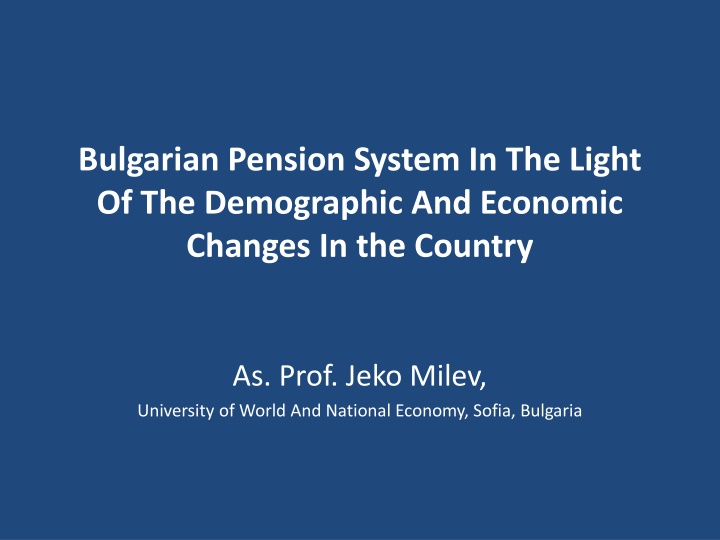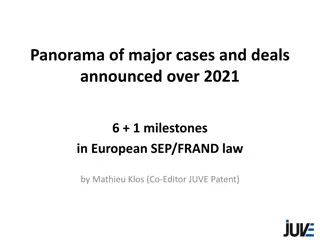
Bulgarian Pension System Changes and Challenges Unveiled
Delve into the Bulgarian pension system and its evolution in response to demographic and economic shifts. Learn about the three-pillar structure, reasons behind reforms, stages of development, and government's changing stance on pension funds.
Download Presentation

Please find below an Image/Link to download the presentation.
The content on the website is provided AS IS for your information and personal use only. It may not be sold, licensed, or shared on other websites without obtaining consent from the author. If you encounter any issues during the download, it is possible that the publisher has removed the file from their server.
You are allowed to download the files provided on this website for personal or commercial use, subject to the condition that they are used lawfully. All files are the property of their respective owners.
The content on the website is provided AS IS for your information and personal use only. It may not be sold, licensed, or shared on other websites without obtaining consent from the author.
E N D
Presentation Transcript
Bulgarian Pension System In The Light Of The Demographic And Economic Changes In the Country As. Prof. Jeko Milev, University of World And National Economy, Sofia, Bulgaria
The pension reform of the early 2000s Three pillar pension system I pillar (Pay-as-you-go and mandatory) II pillar ( Funded and mandatory) III pillar (Funded and voluntary)
Reasons behind the reform of 2000 Economic crises Unfavourable demographic structure Inadequate pension benefits
Two stages in the development of the funded part of the pension system in Bulgaria Until 2008 The government made reforms that supported the private pension funds in the country After 2008 The government started to change pension legislation and to stimulate insured individual to opt out of the second pillar
Why has government changed its attitude towards pension funds? 1. Low yield 2. Low accumulation of resources into the personal accounts 3. Underdeveloped stock market in the country
Year Average monthly contributory income (euro) 132.81 Rate of increase of average monthly contributory income Yield realized by pension funds 10.58% 2002 2003 143.55 8.09% 10.99% 2004 157.89 9.99% 11.92% 2005 169.55 7.39% 7.86% 2006 181.25 6.90% 8.31% 2007 203.58 12.32% 15.67% 2008 255.93 25.72% -20.76% 2009 283.65 10.83% 7.22% 2010 291.61 2 .80% 5.18% 2011 303.78 4.18% -0.96% 2012 316.01 4.02% 7.49% 2013 331.69 4.96% 4.50% 2014 349.39 5.34% 5.70% 2015 371.40 6.3% 1.37% 2016 393.73 6.01% 4.01% 2017 416.70 6.68% 6.09% 2018 455.00 8.32% -4.15%
Why government considers the accumulation of resources into the personal accounts as low The accumulated resources on average are not enough to compensate for the envisaged reduction of the PAYG part of the pension benefit for those individuals insured into the second pillar. The legislation prescribes the PAYG part of the pension benefit to be reduced roughly with the ratio between the contribution paid for the second pillar and that paid for the first one. (currently 5% for the II pillar and 19.8% for the I pillar)
Budget of the State PAYG Pension Fund (thousands euro) Year Revenue Expenses Deficit Year Revenue Expenses Deficit 2002 1 053 438 1 507 915 -30,14% 2010 1 333 735 3 448 400 -61,32% 2003 1 236 585 1 600 872 -22,76% 2011 1 576 099 3 440 775 -54,19% 2004 1 285 491 1 763 583 -27,11% 2012 1 500 770 3 564 282 -57,89% 2005 1 236 399 1 946 351 -36,48% 2013 1 692 897 3 850 580 -56,04% 2006 1 187 306 2 129 118 -44,23% 2014 1 723 721 3 974 404 -56,63% 2007 1 317 640 2 293 997 -42,56% 2015 1 780 841 4 095 209 -56,51% 2008 1 560 631 2 597 717 -39,92% 2016 1 941 680 4 271 086 -54,54% 2009 1 716 268 3 216 613 -46,64% 2017 2 230 717 4 382 906 -49,10% 2018 2 610 417 4 657 449 -43,95%
Number of pensioners, contributing individuals and population in Bulgaria (2007-2017) Number of contributing individuals (in thousands) Relative share pensioners/population Number of population Relative share pensioners/contribut ing individuals Year Number of pensioners (in thousands) (in thousands) 7659.8 2007 2252 2863.5 78.6% 29.4% 2008 2214.9 2851.2 7623.4 77.7% 29.1% 2009 2192.5 2829.8 7585.1 77.5% 28.9% 2010 2191.9 2831.5 7534.3 77.4% 29.1% 2011 2199.6 2765.7 7416.1 79.5% 29.7% 2012 2217.6 2770 7305.9 80.1% 30.4% 2013 2195.9 2729.8 7265.1 80.4% 30.2% 2014 2181.9 2735.1 7223.9 79.8% 30.2% 2015 2177.7 2755.9 7178.0 79.0% 30.3% 2016 2180.9 2765.1 7127.8 78.9% 30.6% 2017 2172.8 2779.8 7075.9 78.2% 30.7%
Why is the underdeveloped stock market in the country an obstacle for the development of the fully funded pension system in Bulgaria? Shares of many public companies are not traded actively. Prices of many financial assets could easily be manipulated. The yield announced by pension funds could be overestimated
What will be the future of the pension system in Bulgaria? The PAYG part of the system will need more and more resources to finance inadequate to the preretirement income pension benefits The future of the funded part of the system depends on the next big crises and the ability of the government to finance the pension benefits at that time. The experience shows that government could destroy the second pillar of the pension systems in CEE countries quite easy






















